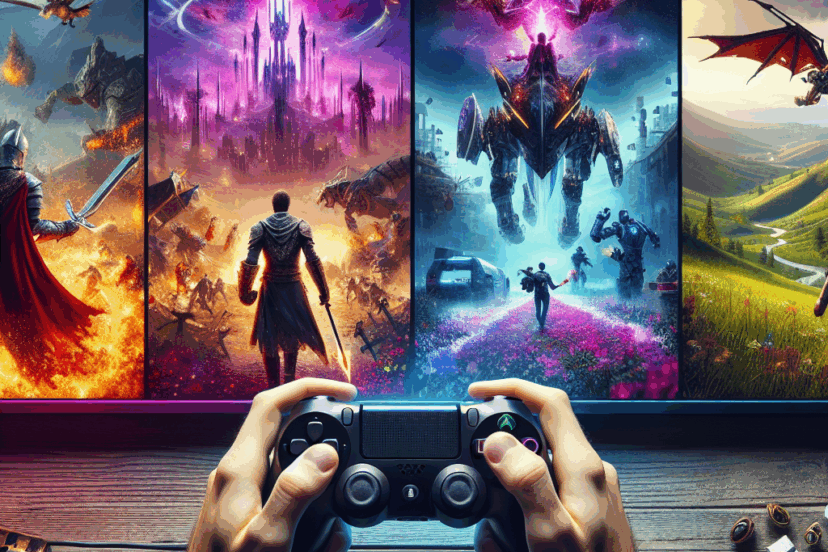Legendary Titles: Classic Games of the 1990s That Still Matter
Legendary Titles: Classic Games of the 1990s That Still Matter
The Cultural Impact of 90s Gaming
The 1990s were transformative for the gaming industry, setting the stage for future advancements in technology, storytelling, and gameplay mechanics. With the introduction of 3D graphics and a burgeoning interest in narrative depth, many titles from this period have become iconic. This article delves into classic games from the 90s that not only shaped the gaming landscape but also continue to resonate with players today.
Super Mario 64: Reinventing 3D Platforming
Released in 1996 for the Nintendo 64, Super Mario 64 was groundbreaking in its use of three-dimensional environments. Mario’s first foray into 3D allowed players to explore vast worlds filled with secrets, challenges, and collectibles. The introduction of an open-world style and camera control changed platforming design forever. With its innovative gameplay and vibrant graphics, Super Mario 64 remains a benchmark for 3D platformers, influencing countless titles that followed.
The Legend of Zelda: Ocarina of Time
Often hailed as one of the greatest video games of all time, The Legend of Zelda: Ocarina of Time pushed boundaries when it was released in 1998. It introduced a dynamic combat system and a rich narrative intertwined with time travel and exploration. The game’s innovative targeting system, Z-targeting, revolutionized how players interacted with environments and enemies. To this day, many game design principles take cues from Ocarina of Time, particularly in terms of storytelling and open-world mechanics.
Final Fantasy VII: A Defining RPG Experience
In 1997, Final Fantasy VII raised the bar for role-playing games with its emotional storytelling and unforgettable characters. The game was one of the first to utilize CGI cutscenes effectively, creating a cinematic experience that captivated players. With its complex narrative themes, such as environmentalism and identity, Final Fantasy VII resonated deeply with audiences. It not only solidified the popularity of the Final Fantasy franchise but also inspired a resurgence of RPGs in the West.
Duke Nukem 3D: The Birth of First-Person Shooters
Duke Nukem 3D, released in 1996, was a pioneer in the first-person shooter genre, known for its humor, interactive environments, and fast-paced action. Its 3D graphics and the ability to shoot through doors and windows made gameplay more engaging. The game’s irreverent tone and memorable one-liners left a lasting impact on the genre, influencing future titles like Halo and Call of Duty. Duke’s larger-than-life persona set the stage for character-centric shooters.
Street Fighter II: A Fighting Game Revolution
Launched in 1991, Street Fighter II transformed the fighting game genre, establishing mechanics that would become standard in future titles. With its diverse cast of characters and innovative gameplay that focused on combos and special moves, Street Fighter II paved the way for competitive fighters. The title not only popularized arcade gaming but also helped launch a franchise that remains successful today. Its influence can be seen in countless games, including Super Smash Bros. and contemporary fighting games.
Doom: Pioneering the First-Person Shooter
Doom, released in 1993, is often credited with popularizing the first-person shooter genre. With its fast-paced gameplay and multiplayer capabilities, Doom created a cultural phenomenon. The game utilized 3D graphics cleverly, giving players a sense of immersion that was unprecedented at the time. Its modding community also demonstrated the potential for user-generated content, setting the stage for future FPS titles and fostering gaming communities online.
Pokémon Red and Blue: The Start of a Cultural Phenomenon
The release of Pokémon Red and Blue in 1996 introduced players to the immersive world of Pokémon, where trainers could catch, battle, and trade creatures. The games blended elements of strategy and exploration, captivating millions worldwide. The immense success of Pokémon gave rise to an entire franchise that spans games, TV shows, trading cards, and movies. Its impact on gaming is still felt today, as new generations continue to experience the joy of becoming Pokémon Masters.
The Sims: Life Simulation Innovation
Launched in 2000, The Sims revolutionized life simulation games. Players could create and control virtual people, building homes and managing their lives. With its open-ended gameplay, the Sims allowed players to explore the complexities of life in a fun, engaging manner. The franchise has evolved into one of the best-selling series of all time, reflecting societal changes and player interests over the decades.
GoldenEye 007: Redefining Multiplayer FPS
GoldenEye 007, released in 1997 for the Nintendo 64, is often considered the game that brought first-person shooters to home consoles. Its engaging single-player campaign combined with intense multiplayer matches redefined gaming nights. Players dove into the world of espionage with a variety of weapons, gadgets, and levels, making it a staple for multiplayer gaming. The game’s influence can be seen in modern FPS titles, emphasizing the importance of multiplayer modes.
Resident Evil: The Birth of Survival Horror
Released in 1996, Resident Evil established the survival horror genre, combining atmospheric tension with strategic gameplay. The game’s fixed camera angles and resource management created a unique experience, emphasizing exploration and puzzle-solving. With its gripping storyline and iconic monsters, Resident Evil not only launched a successful franchise but influenced countless horror games, focusing on psychological terror.
Castlevania: Symphony of the Night
Castlevania: Symphony of the Night, released in 1997, is often celebrated as one of the best Metroidvania games. Its non-linear exploration and RPG elements allowed players to immerse themselves in a captivating gothic world filled with secrets. The game introduced many mechanics, such as leveling up and gear management, that are standard in modern titles. The emphasis on discovery and atmosphere was revolutionary, influencing countless games that sought to replicate its success.
Sonic the Hedgehog 2: The Fastest Mascot
Released in 1992, Sonic the Hedgehog 2 advanced the franchise with new gameplay mechanics and faster levels. Sonic became a cultural icon, representing the Sega Genesis and expanding the platforming genre. Co-op gameplay with the introduction of Tails added a unique layer to the experience, allowing for shared adventures. Your experience with Sonic 2 remains fresh in many players’ minds, leading to ongoing interest in both the franchise and its many spin-offs.
Tetris: The Timeless Puzzle Classic
Tetris, though developed in the 1980s, gained massive popularity in the 90s with its portable versions on Game Boy. This legendary puzzle game introduces players to falling blocks that players must align to clear lines. Its simple yet addictive gameplay has made it a timeless classic, influencing countless puzzle games. Tetris’ legacy endures because it challenges players’ strategic thinking and reflexes, remaining relevant in competitive gaming.
Baldur’s Gate: A Benchmark for RPG Storytelling
In 1998, Baldur’s Gate redefined isometric role-playing games. Its intricate narrative, rooted in Dungeons & Dragons lore, allowed players to explore deep character customization and story choices. The game set a new standard for RPG storytelling, emphasizing player agency and narrative depth. Its real-time combat with pause mechanics was innovative, influencing RPGs that followed. Baldur’s Gate’s successful blend of storytelling and character building remains a benchmark in the RPG genre.
Conclusion: The Enduring Legacy of 90s Games
From revolutionary mechanics to storytelling breakthroughs, the classic games of the 1990s laid the groundwork for contemporary gaming culture. These legendary titles continue to inspire developers and engage players, demonstrating the timeless nature of great game design. The impact of these games resonates today, reminding us of the passion and creativity that defined an era.




